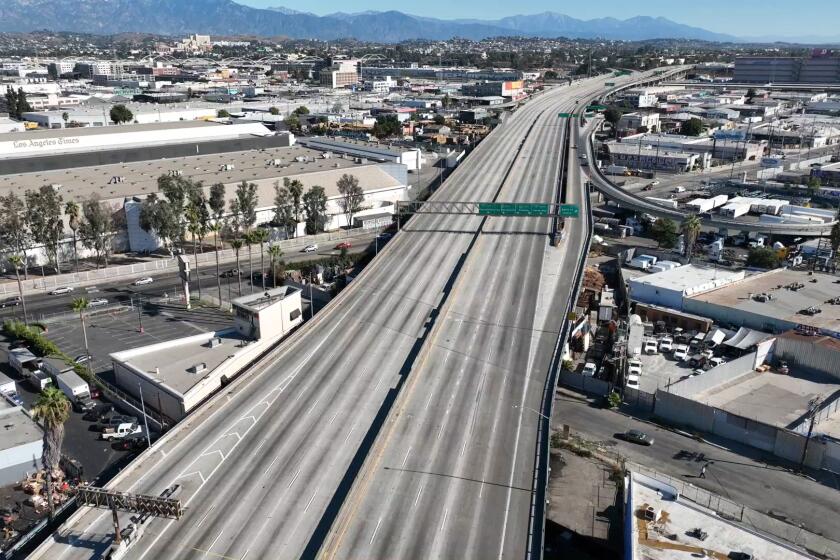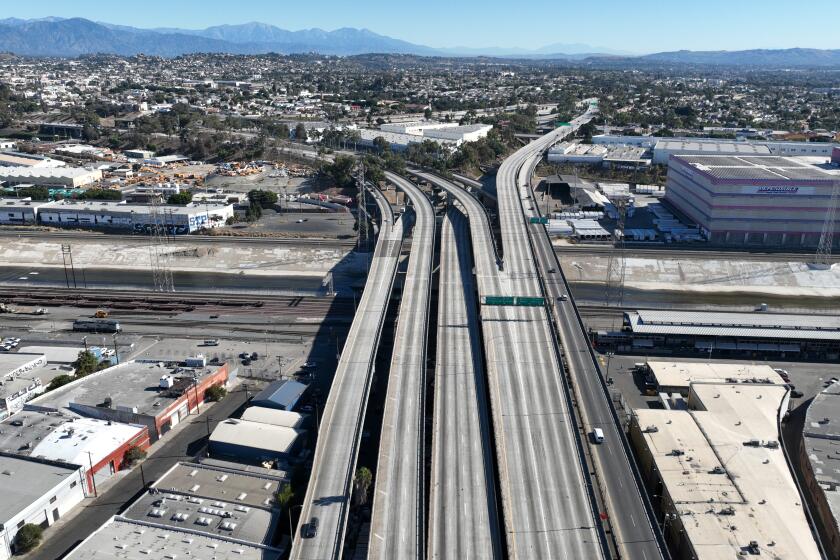10 Freeway damage not as severe as expected, engineer says, but more tests are needed

- Share via
Preliminary tests show that damage to the 10 Freeway in downtown Los Angeles from Saturday’s massive fire is not as severe as initially feared, according to a bridge engineer with Caltrans who was not authorized to speak publicly.
Caltrans engineers met with senior management Monday to provide an assessment of the damage and possible timelines for getting traffic moving across this critical link in the region’s freeway system.
“The results were very good,” said the engineer, who described two scenarios contingent upon the damaged freeway being shored up and supported from underneath.
In the worst case, the shoring will be removed in stages — one direction, then another — so lanes can be replaced and the portions of the road can be kept open to traffic. In the best case scenario, the shoring will stay in place, allowing repairs to be made without closing down any lanes.
“The best case is where I think we’re headed,” said the engineer, who argues that the state transportation agency was lucky the fire didn’t lead to more severe damage.
There is no timeline for when the freeway will be reopened, but officials say the work will not happen swiftly.
“Caltrans has known about this for a long time,” the engineer said. “They have permitted lessees to store flammable stuff underneath these freeways for decades. They’ve had a couple of fires in the last three years that have affected columns, but inspectors can’t completely get underneath the bridge to make a thorough inspection because of all the junk.”
A Caltrans spokesperson declined to comment on the engineer’s statements.
In 2017, a similar fire caused a portion of the 85 Freeway in Atlanta to collapse after combustible materials stored under the freeway caught fire. The closure snarled commuter traffic for six weeks. Afterwards, Caltrans wrote a policy directive directly based on that incident that prohibited the storage of flammable materials under its bridges and required access for bridge inspections.
In addition to pallets, sanitizer accumulated during the height of the COVID-19 pandemic was stored under the overpass and helped fuel the flames, according to sources familiar with the probe. The cause of the fire is being investigated as possible arson.
Debris is still blocking access underneath the freeway, but as soon as the site can be accessed, experts will make a complete assessment and crews can begin to raise shoring underneath the freeway.
“They can get that shoring up really fast,” the engineer said.
Of particular concern is a 1,500-foot stretch of the freeway between 14th and Elwood streets that had sheltered not only pallet storage yards but also a number of homeless encampments. Clearing out this area and assessing it for hazardous waste have been challenges, said the engineer.
In this area, the underside of the freeway shows signs of fire damage, said the engineer, but after an initial exam, that damage doesn’t appear to be structural.
Nearly 100 columns were affected by the fire, and the Caltrans engineering staff is looking at 45 columns that show the most severe fire damage. Shoring is being erected near Lawrence Street to take the weight off of the most compromised columns.
With a state of emergency declared by Gov. Gavin Newsom, commuters have been left scrambling to find alternate routes around the closure, snarling traffic on other freeways and side streets. About 300,000 vehicles pass each day through this mile long stretch of freeway that extends from the East Los Angeles interchange and Alameda Street.
A crucial stretch of the 10 Freeway remains closed through downtown L.A. after a major fire damaged the highway. Here is what we know.
As of Monday morning, engineers had completed core testing on the concrete on both the deck and one of the 45 columns. Testing also took place on the steel, known as rebar, inside the freeway and the columns to see if its strength was compromised by the fire as well.
“The compression tests for the concrete are looking very good,” the bridge engineer said. “And the tests on the rebar are looking good as well.”
Because water is used in the manufacture of concrete — helping to create the bond between cement and small stones known as aggregate — water molecules can dry out when exposed to fire and heat, causing the concrete to crack. Cracking reduces the strength of the material, leading to exfoliation of the surface, or spalling.
Compression testing places pressure on the concrete sample to measure how much weigh it can bear before failing. Results from another technique known as petrographic testing, in which dyes are applied to samples of the concrete core to highlight any microscopic cracking, are still outstanding.
Caltrans expects to have completed its testing of all 45 columns and a decision on whether the freeway will need to be replaced or repaired by the end of the week, according to the engineer.
More to Read
Sign up for Essential California
The most important California stories and recommendations in your inbox every morning.
You may occasionally receive promotional content from the Los Angeles Times.
















